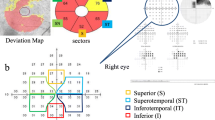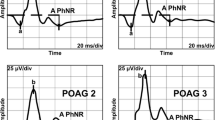Abstract
The purpose of the study is (1) to demonstrate the anatomical variation of cone photoreceptor density across normal retina as a sectoral amplitude asymmetry of photopic multifocal electroretinogram (mfERG) and (2) to study the potential presence of sequential or differential, functional cone photoreceptor damage in glaucoma using this amplitude asymmetry. A 37-Block scaled mfERG was recorded from 22 controls and 27 glaucoma subjects. The N1 and P1 amplitudes of averaged responses from corresponding zones nasal and temporal to fovea were analyzed for asymmetry in controls and glaucoma subjects. Amplitude asymmetry was demonstrable for both N1 (p < 0.001) and P1 (p < 0.001) parameters in control subjects. Although this amplitude asymmetry was preserved in glaucoma subjects with moderate field defects, it was not demonstrable in patients with advanced field defects. The anatomical variation in cone photoreceptor distribution across normal retina is demonstrated as an amplitude asymmetry in first order kernel responses of mfERG. The cone photoreceptors in the region nasal to fovea appear to be affected only in advanced glaucoma possibly suggesting that photoreceptors could follow a sequential damage like the overlying neuroretinal rim in glaucoma.



Similar content being viewed by others
References
Sutter EE (1991) The fast m-transform: a fast computation of cross-correlations with binary m-sequences. Soc Ind Appl Math 20:686–694
Sutter EE, Tran D (1992) The field topography of ERG components in man, I: the photopic luminance response. Vis Res 32:433–466
Hood DC, Bach M, Brigell M, Keating D, Kondo M, Lyons JS, Palmowski-Wolfe AM (2008) ISCEV guidelines for clinical multifocal electroretinography (2007 edition). Doc Ophthalmol 116:1–11
Hood DC, Frishman LJ, Saszik S, Viswanathan S (2002) Retinal origins of the primate multifocal ERG: implications for the human response. Invest Ophthalmol Vis Sci 43(5):1673–1685
Jonas JB, Schneider U, Naumann GO (1992) Count and density of human retinal photoreceptors. Graefes Arch Clin Exp Ophthalmol 230(6):505–510
Curcio CA, Sloan KR, Kalina RE, Hendrickson AE (1990) Human photoreceptor topography. J Comp Neurol 292(4):497–523
Hitchings RA, Wheeler CA (1980) The optic disk in glaucoma (IV. Optic disc evaluation in the ocular hypertensive patient). Br J Ophthalmol 64:232–239
Hitchings RA (1978) The optic disk in glaucoma (III. Diffuse optic disk pallor with raised intraocular pressure). Br J Ophthalmol 62:670–675
Hitchings RA, Spaeth GL (1977) The optic disk in glaucoma (II. Correlation of the appearance of the optic disc with the visual field). Br J Ophthalmol 61:107–113
Jonas JB, Fernández M, Stürmer J (1993) Pattern of glaucomatous neuroretinal rim loss. Ophthalmology 100:63–67
Kirsch RE, Anderson DR (1973) Clinical recognition of glaucomatous cupping. Am J Ophthalmol 75:442–454
Pederson JE, Anderson DR (1980) The mode of progressive disc cupping in ocular hypertension and glaucoma. Arch Ophthalmol 98:490–495
Tuulonen A, Airaksinen PJ (1991) Initial glaucomatous optic disk and retinal nerve fiber layer abnormalities and the mode of their progression. Am J Ophthalmol 111:485–490
Kendell KR, Quigley HA, Kerrigan LA, Pease ME, Quigley EN (1995) Primary open angle glaucoma is not associated with photoreceptor loss. Invest Ophthalmol Vis Sci 36:200–205
Panda S, Jonas JB (1992) Decreased photoreceptor count in human eyes with secondary angle closure glaucoma. Invest Ophthalmol Vis Sci. 33:2532–2536
Hodapp E, Parrish RK, Anderson DR (1993) Clinical decisions in glaucoma. The CV: Mosby Co, St. Louis, pp 52–61
Wilker KC, Williams RW, Rakic P (1990) Photoreceptor mosaic: number and distribution of cones and rods in rhesus monkey retina. J Comp Neurol 297:499–508
Curcio CA, Millican CL, Allen KA, Kalina RE (1993) Aging of the human photoreceptor mosaic: evidence for selective vulnerability of rods in central retina. Invest Ophthalmol Vis Sci 34:3278–3296
Hood DC, Frishman LJ, Viswanathan S, Robson JG, Ahmed J (1999) Evidence for a substantial ganglion cell contribution to the primate electroretinogram (ERG): effect of TTX on the multifocal ERG in macaque. Vis Neurosci 16(3):411–416
Hood DC, Greenstein V, Frishman LJ, Holopigian K, Viswanathan S, Seiple W, Ahmed J, Robson JG (1999) Identifying inner retinal contributions to the human multifocal ERG. Vis Res 39:2285–2291
Sutter EE, Bears MA (1999) The optic nerve component of human ERG. Vis Res 39:419–436
Bearse MA, Sutter EE (1998) Contrast dependence of multifocal ERG components. Visual science and its application, OSA Technical Digest Series 24–27
Jonas JB, Gusek GC, Naumann GOH (1988) Optic disc, cup and neuroretinal rim size, configuration, and correlations in normal eyes. Invest Ophthalmol Vis Sci 29:1151–1158
DeLeón-Ortega JE, Arthur SN, McGwin G, Xie A, Monheit BE, Girkin CA (2006) Discrimination between glaucomatous and nonglaucomatous eyes using quantitative imaging devices and subjective optic nerve head assessment. Invest Ophthalmol Vis Sci 47:3374–3380
Quigley HA, Addicks EM, Green WR, Maumenee AE (1982) Optic nerve damage in human glaucoma. III. Quantitative correlation of nerve fiber loss and visual field defect in glaucoma, ischaemic optic neuropathy, papilledema and toxic neuropathy. Arch Ophthalmol 100:135–146
Karlberg B, Hedin A, Bjornberg K (1968) Electroretinography during short-term intraocular tension rise. Acta Ophthalmol 46:742–747
Alvis DL (1966) Electroretinographic changes in controlled chronic open angle glaucoma. Am J Ophthalmol 61:121–131
Bartl G, Benedikt O, Hiti H (1978) The effect of elevated intraocular pressure on the human ERG and VER. Graefes Arch Clin Exp Ophthalmol 207:275–279
Fazio DT, Heckenlively JR, Martin DA, Christensen RE (1986) The Electroretinogram in advanced open angle glaucoma. Doc Ophthalmol 63:45–54
Velton IM, Korth M, Horn FK (2001) The a-wave of the dark-adapted Electroretinogram in glaucomas: are photoreceptors affected? Br J Ophthalmol 85:397–402
Velton IM, Horn FK, Korth M, Velten K (2001) The b-wave of the dark-adapted Electroretinogram in patients with advanced asymmetrical glaucoma and normal subjects. Br J Ophthalmol 85:403–409
Viswanathan S, Frishman LJ, Robson JG, Harwerth RS, Smith EL (1999) The photopic negative response of the macaque electroretinogram: reduction by experimental glaucoma. Invest Ophthalmol Vis Sci 40:1124–1136
Hood DC, Greenstein VC, Holopigian K, Bauer R, Firoz B, Liebmann JM, Odel JG, Ritch R (2000) An attempt to detect glaucomatous damage to the inner retina with the multifocal ERG. Invest Ophthalmol Vis Sci 41:1570–1579
Hasegawa S, Takagi M, Usui T, Takada R, Abe H (2000) Waveform changes of the first order multifocal electroretinogram in patients with glaucoma. Invest Ophthalmol Vis Sci 41:1597–1603
Klistorner A, Graham SL, Martins A (2000) Multifocal pattern electroretinogram does not demonstrate localized field defects in glaucoma. Doc Ophthalmol 100:155–165
Acknowledgments
The authors are thankful to Dr. Rashmi Rodriguez and Dr. Pretesh R Kiran (St. John’s medical college, Bangalore) for assistance in statistics. The authors are thankful to Dr. Charlier, J (Metrovision, France) for customizing mfERG stimulus. The authors are thankful to Dr. Somashekhar N and Dr. Prasanth CN (Narayana Nethralaya, Bangalore) for assistance in recruiting control subjects. The authors are thankful to Mrs. Vijayalakshmi Pires (PhD Eng Litt) and Mrs. Thaliath, NMAF for assistance in English language editing. The authors are thankful to Mrs Revathi MP for assistance in mfERG recording and Mr. Muhammed Naizal T (Narayana Ophthalmic Multimedia Art Department) for assistance in figures.
Conflict of interest statements
No conflict for any author.
Financial disclosure
None of the authors have any financial interests to disclose.
Author information
Authors and Affiliations
Corresponding author
Rights and permissions
About this article
Cite this article
Vincent, A., Shetty, R., Devi, S.A.V. et al. Functional involvement of cone photoreceptors in advanced glaucoma: a multifocal electroretinogram study. Doc Ophthalmol 121, 21–27 (2010). https://doi.org/10.1007/s10633-010-9227-0
Received:
Accepted:
Published:
Issue Date:
DOI: https://doi.org/10.1007/s10633-010-9227-0




